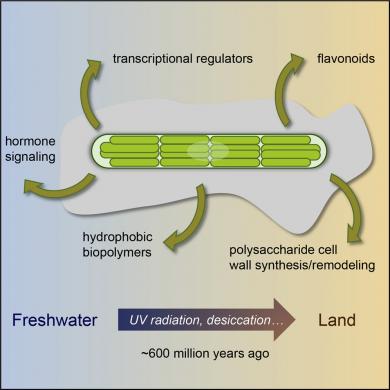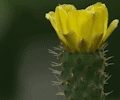The recipe for successful life on land
One of the most significant events in the history of life on Earth took place about 500 million years ago, when a freshwater alga developed the ability to colonize land. This process had a profound impact on the living conditions on earth. The first land colonization by simple representatives of the ornamental algae (Zygnematophyceae) paved the way for a later explosion of flora and fauna as we know it today. For the first time, researchers from the USA and Canada, in cooperation with Prof. Dr. Alisdair Fernie from the Max Planck Institute for Molecular Plant Physiology, have investigated the genome of a representative of this algae species and have elucidated the genetic basis that enabled the algae to adapt to life on land.
Our earth without animals or plants is unimaginable for many. Whether tiny insects, mammals or stately trees: in the course of evolution, a diverse flora and fauna has developed on our planet, whose origin can be traced back to the colonization of the land by algae of a single species. The shore leave of these algae was the starting point for changing the geochemical composition of the soil, increasing the oxygen content and, together with other factors, reducing the carbon dioxide content, so that life on earth could develop as we know it today. While the relationship between algae and plants is widely known today, we still hardly understand the evolutionary mechanisms that enabled the ancestors of our land plants to adapt to the aridity and high solar radiation on land. In order to gain insights into these adaptation mechanisms, only genome sequences of photosynthetically active organisms and land plants have been compared to analyze similarities and differences. However, a completely sequenced genome of a representative of the ornamental algae was missing until now.
In a study recently published in the journal "Cell", scientists led by Prof. Jocelyn Rose from the Cornell University in the USA, in collaboration with Prof. Alisdair Fernie from the Max Planck Institute for Molecular Plant Physiology in Potsdam, Germany, have now sequenced the genome of the jewelry alga Penium margaritaceum. By analyzing the data, the researchers identified the elementary genetic conditions that enabled the transition from aquatic to terrestrial plants.
Evidence for the close relationship of P. margaritaceum with land plants
P. margaritaceum is a unicellular alga and belongs to the group of decorative algae. By analyzing the sequencing data, the scientists found out that P. margaritaceum evolved about 552-663 million years ago and that about 80% of its genome consists of repeats. The genome contains more than 53,000 protein-coding genes and thus contains more genes than, for example, the genome of the potato (approx. 39,000 genes) or maize (approx. 32,000 genes). The alga has a simple body structure, but has a complex cell wall similar to that of land plants. To confirm the close relationship to land plants, the genome of P. margaritaceum was compared with 13 already known genomes of other green plants. A large number of common genes were found, some of which have already been functionally characterized in other plants and can therefore be assumed to have the same function in P. margaritaceum. Interestingly, these are mainly genes called transcription factors, that control other genes in response to stress factors such as water shortage, cold or light.
Adaptability to stress conditions as a recipe for success in life on land
A decisive step towards living outside the water is based on the ability to adapt to harmful environmental conditions such as drought, extreme temperatures or UV radiation. To protect themselves from dehydration, the first land-living organisms needed complex cell walls that prevented water loss. Although P. margaritaceum is a unicellular alga, many genes have been identified that influence the structure and composition of the cell wall. The scientists assume that P. margaritaceum has already been able to synthesize and secrete some protective biopolymers and this paved the way for the formation of lignin, cutin and suberine in plant cell walls. In addition, the researchers found out in a drought stress experiment that P. margaritaceum secreted a mucus layer consisting of polysaccharides. This provides additional protection against dehydration, so that the algae were well adapted to dry habitats.
As there were no shade-giving trees on earth at the time of the first land colonisation, the first ornamental algae were mercilessly exposed to the high light intensity and UV radiation on land. In order to adapt to high solar radiation, they needed protective mechanisms. To test the adaptation of P. margaritaceum to this light stress, the scientists cultivated the algae in the laboratory under increased light intensity.
In response to the high light intensity, photosynthesis was switched off to prevent cell damage - a reaction that can also be observed in land plants. In addition, the research group led by Prof. Alisdair Fernie from Potsdam was able to detect various flavonoids by means of mass spectrometry. Due to their antioxidative effect, these flavonoids are of crucial importance for protection against UV radiation. "In response to the high light intensity, photosynthesis was switched off in order to prevent cell damage - a reaction that is also shown by land plants", Prof. Fernie explains the experiment and adds: "In addition, we were able to detect various flavonoids by means of mass spectrometry, which are of decisive importance for protection against UV radiation due to their antioxidant effect".
In summary, this study has identified a number of genes that help the algae adapt to a short-lived, semi-terrestrial lifestyle. The reason for the development of the algae's ability to tolerate environmental stress on land is that it has lived in shallow wetlands with fluctuating water levels, which at times even dried up. Thus, this ancient algae of the Zygnematophyceae has the genetic prerequisites for life on land and can be regarded as an ancestor of our land plants.
In the further course of evolution, the development of multicellular life forms offers an additional advantage for life on land, as it creates a larger surface area for photosynthesis and the absorption of nutrients and water from the new habitat.
Contact
Prof. Dr. Alisdair Fernie
Max Planck Institute of Molecular Plant Physiology
Phone: 0331/567 8211
Fernie@mpimp-golm.mpg.de
Dr. Björn Plötner
Public Relations
Max Planck Institute of Molecular Plant Physiology
Phone: 0331/567 8275
Ploetner@mpimp-golm.mpg.de
Original Publication
Jiao, C., Sorensen, I., Sun, X., Sun, H., Behar, H., Alseekh, S., Philippe, G., Palacio Lopez, K., Sun, L., Reed, R., Jeon, S., Kiyonami, R., Zhang, S., Fernie, A.R., Brumer, H., Domozych, D.S., Fei, Z. and Rose, J.K.C.
The Penium margaritaceum Genome: Hallmarks of the Origins of Land Plants.
Cell, 28.05.2020, doi: https://doi.org/10.1016/j.cell.2020.04.019












